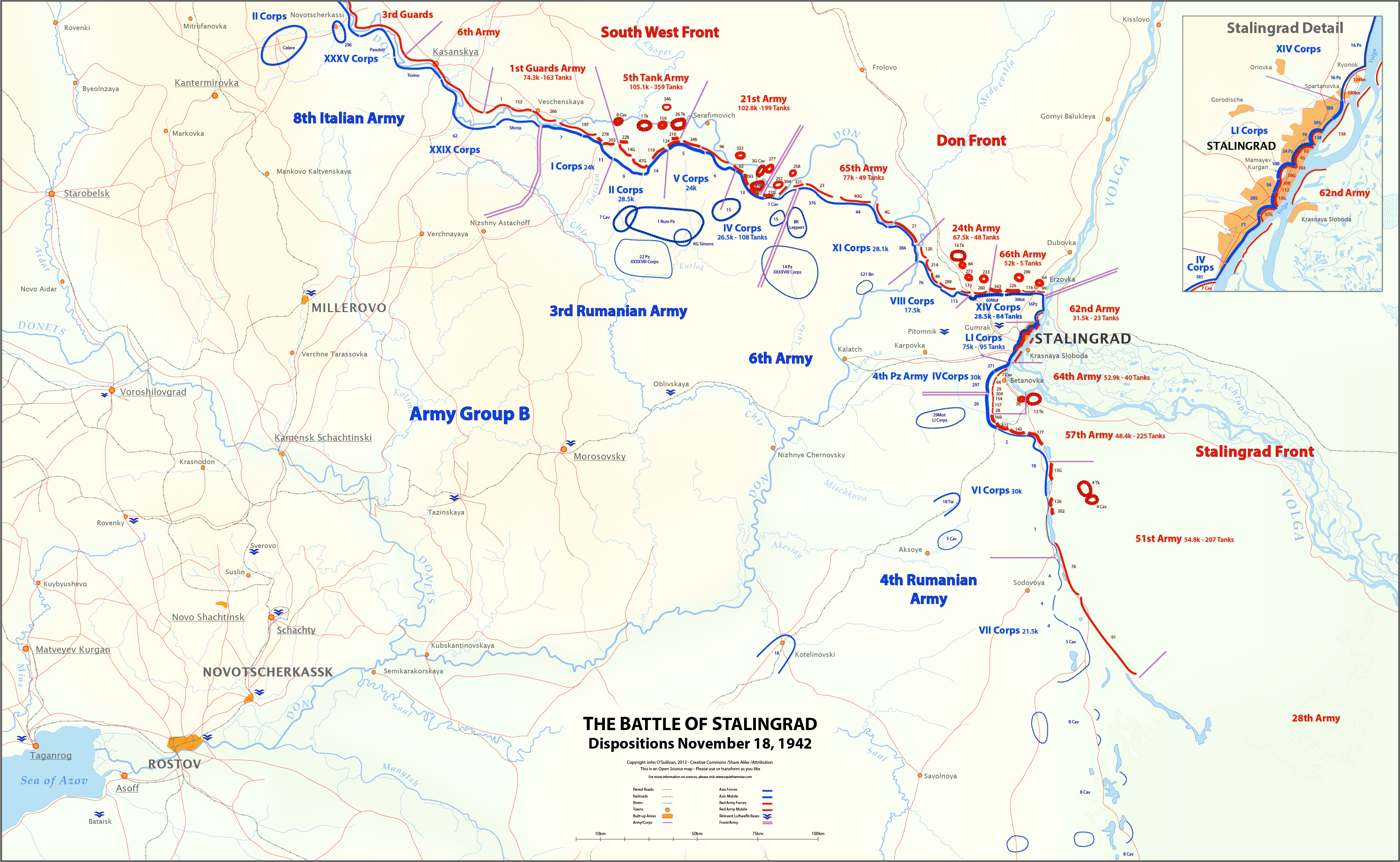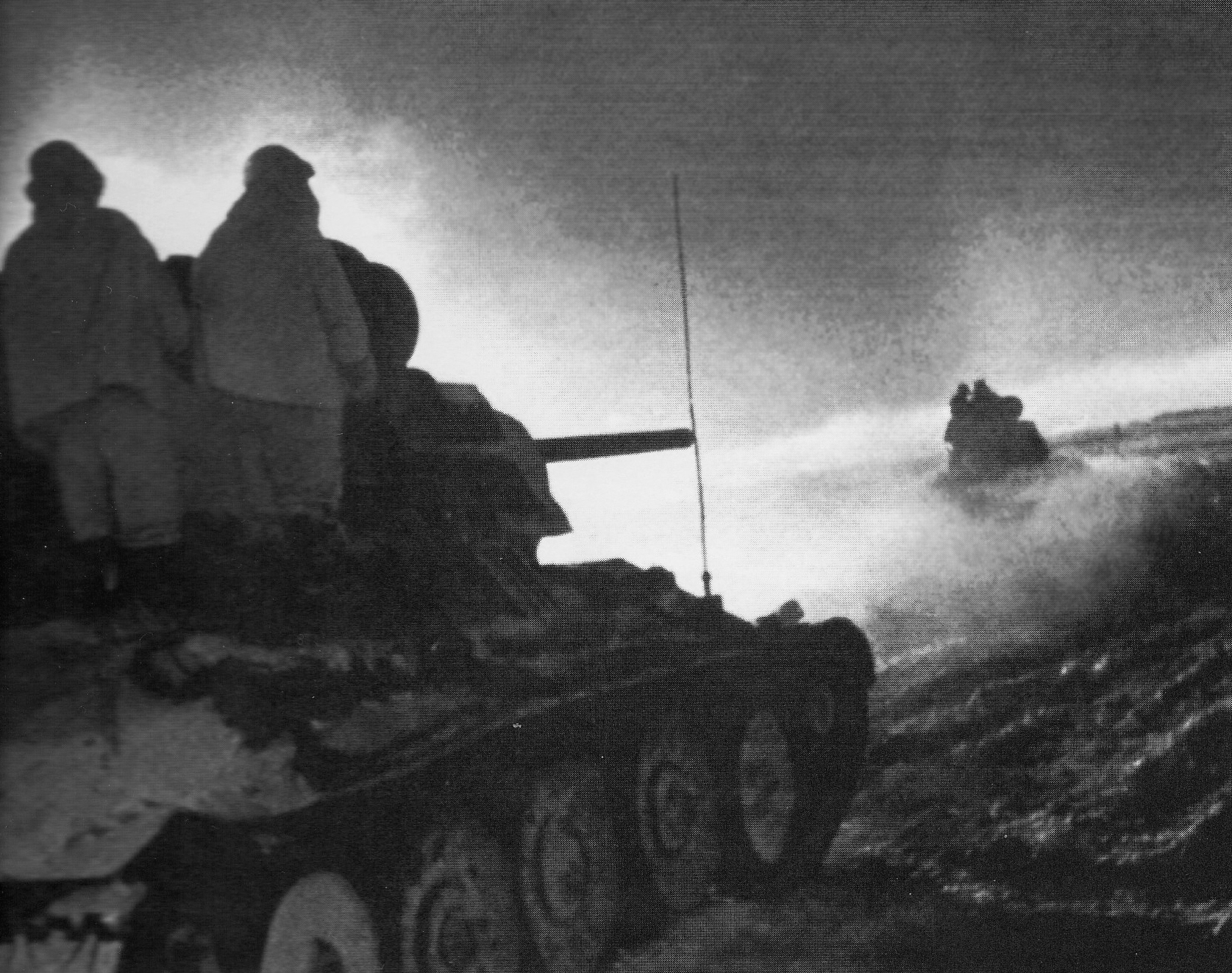|
Operation Uranus
Operation Uranus () was a Soviet 19–23 November 1942 strategic operation on the Eastern Front of World War II which led to the encirclement of Axis forces in the vicinity of Stalingrad: the German Sixth Army, the Third and Fourth Romanian armies, and portions of the German Fourth Panzer Army. The Red Army carried out the operation at roughly the midpoint of the five-month long Battle of Stalingrad, aiming to destroy German forces in and around Stalingrad. Planning for Operation Uranus had commenced in September 1942, and developed simultaneously with plans to envelop and destroy German Army Group Center ( Operation Mars) and German forces in the Caucasus. Due to the length of the front lines created by the German 1942 summer offensive, which had aimed at taking the Caucasus oil fields and the city of Stalingrad, German and other Axis forces were over-extended. The German decision to transfer several mechanized divisions from the Soviet Union to Western Europe exa ... [...More Info...] [...Related Items...] OR: [Wikipedia] [Google] [Baidu] |
Battle Of Stalingrad
The Battle of Stalingrad ; see . rus, links=on, Сталинградская битва, r=Stalingradskaya bitva, p=stəlʲɪnˈɡratskəjə ˈbʲitvə. (17 July 19422 February 1943) was a major battle on the Eastern Front of World War II, beginning when Nazi Germany and its Axis allies attacked and became locked in a protracted struggle with the Soviet Union for control over the Soviet city of Stalingrad (now known as Volgograd) in southern Russia. The battle was characterized by fierce close-quarters combat and direct assaults on civilians in aerial raids; the battle epitomized urban warfare, being the single largest and costliest urban battle in military history. It was the bloodiest and fiercest battle of the entirety of World War II—and arguably in all of human history—as both sides suffered tremendous casualties amidst ferocious fighting in and around the city. The battle is commonly regarded as the turning point in the European theatre of World War II, as Germany ... [...More Info...] [...Related Items...] OR: [Wikipedia] [Google] [Baidu] |
Kalach-na-Donu
Kalach-na-Donu (), or Kalach-on-the-Don, is a town and the administrative center of Kalachyovsky District in Volgograd Oblast, Russia, located on the Don River, west of Volgograd, the administrative center of the oblast. Population: The town is unofficially divided into several parts: Starii Kalach (“Old Kalach”, located in the northwest, closest to the bridge); the main part of the city (has no name, and its areas correspond to the names of bus stops), Stroyrayon ("District of new houses", the newest part of the town) and the village of Cherkasovo. History It was founded in 1708 as a Cossack ''sloboda'' and was originally called Kalach ()."My Town" EncyclopediaEntry on Kalach-na-Donu In 1862, the Volga-Don Railway was built from Tsaritsyn to Kalach - the oldest operating railway in the territory of the modern Volgograd region. This railroad brought prosperity to the town in the early 20th century. During the Russian Civil War, Kalach was important in the defense of Ts ... [...More Info...] [...Related Items...] OR: [Wikipedia] [Google] [Baidu] |
Stavka
The ''Stavka'' ( Russian and Ukrainian: Ставка, ) is a name of the high command of the armed forces used formerly in the Russian Empire and Soviet Union and currently in Ukraine. In Imperial Russia ''Stavka'' referred to the administrative staff, and to the General Headquarters in the late 19th-century Imperial Russian armed forces and subsequently in the Soviet Union. In Western literature it is sometimes written in uppercase (''STAVKA''), although it is not an acronym. ''Stavka'' may refer to its members, as well as to the headquarters location (its original meaning from the old Russian word '' ставка'', 'tent'). Stavka of the Supreme Commander during World War I The commander-in-chief of the Russian army at the beginning of World War I was Grand Duke Nicholas Nicholaievitch, a grandson of Tsar Nicholas I. Appointed at the last minute in August 1914, he played no part in formulating the military plans in use at the beginning of the war. Nikolai Yanushke ... [...More Info...] [...Related Items...] OR: [Wikipedia] [Google] [Baidu] |
29th Infantry Division (Wehrmacht)
The 29th Infantry Division was a unit of the German army created in the fall of 1936. It was based on the old Reichswehr 15th Infantry Regiment and drew its initial recruits from Thuringia. It was upgraded to 29th Motorized Infantry Division in the fall of 1937. The division was also known as the Falke-Division (Falcon Division). Operational history The division was mobilized in August 1939 and joined the XIV Corps of the German 10th Army for the invasion of Poland. On 8 September 1939, forces of the 29th Infantry Division occupied Lipsko, where members of the division's 71st Infantry Regiment's third battalion staged a pogrom on 9 September, killing between 60 and 80 Jewish inhabitants of the town. The division took part in the encirclement of Polish forces at Radom, Poland and committed the Massacre in Ciepielów, where about 300 Polish prisoners of war were executed. In December 1939 it was transferred to the west. During the invasion of France it joined the 16th A ... [...More Info...] [...Related Items...] OR: [Wikipedia] [Google] [Baidu] |
XXXXVIII Panzer Corps
XXXXVIII Panzer Corps (also: XXXXVIII Army Corp or XXXXVIII. Armeekorps), was a corps-level formation of the German Army which saw extensive action on both the Eastern and Western Fronts during World War II. History The corps was originally formed on 15 December 1940 in Germany. At the dawn of Operation Barbarossa, on 22 June 1941, the Corps was attached to Field Marshal Ewald von Kleist's Panzer Group 1, a part of Army Group South. The corps took part in the Battle of Brody early in the campaign, and later saw action at Berdichev and Kirovograd. As did all German Corps on the Eastern Front, the XLVIII Motorized Corps implemented the criminal Commissar Order. From late 1941 to May 1942, the corps took part in defensive operations in the Kursk area. It was renamed the XLVIII Panzer Corps in early summer 1942. Thereafter the corps joined the Fall Blau offensive towards Stalingrad under Army Group B. During the Battle of Stalingrad the 29th Motorized Infantry Division (tr ... [...More Info...] [...Related Items...] OR: [Wikipedia] [Google] [Baidu] |
Division (military)
A division is a large military unit or Formation (military), formation, usually consisting of between 10,000 and 25,000 soldiers. In most armies, a division is composed of several regiments or brigades; in turn, several divisions typically make up a corps. Historically, the division has been the default combined arms unit capable of independent Military tactics, operations. Smaller combined arms units, such as the American regimental combat team (RCT) during World War II, were used when conditions favored them. In recent times, modern Western militaries have begun adopting the smaller brigade combat team (similar to the RCT) as the default combined arms unit, with the division to which they belong being less important. A similar word, ''Divizion, //'', is also used in Slavic languages (such as Russian, Serbo-Croatian, and Polish) for a battalion-size artillery or cavalry unit. In naval usage "division (naval), division" has a completely different range of meanings. Aboard ship ... [...More Info...] [...Related Items...] OR: [Wikipedia] [Google] [Baidu] |
Volgograd
Volgograd,. formerly Tsaritsyn. (1589–1925) and Stalingrad. (1925–1961), is the largest city and the administrative centre of Volgograd Oblast, Russia. The city lies on the western bank of the Volga, covering an area of , with a population of slightly over one million residents. Volgograd is the 16th-largest city by population size in Russia, the third-largest city of the Southern Federal District, and the fourth-largest city on the Volga. The city was founded as the fortress of ''Tsaritsyn'' in 1589. By the 19th century, Tsaritsyn had become an important river-port and commercial centre, leading to its rapid population growth. In November 1917, at the start of the Russian Civil War, Tsaritsyn came under Bolshevik control. It fell briefly to the White Army in mid-1919 but returned to Bolshevik control in January 1920. In 1925, the city was renamed ''Stalingrad'' in honor of Joseph Stalin, who took part in defending the city against the White Army who had then ruled the ... [...More Info...] [...Related Items...] OR: [Wikipedia] [Google] [Baidu] |
Caucasus Oil Fields
The petroleum industry in Azerbaijan produced about 33 million tonnes of oil and 35 billion cubic meters of gas in 2022. Azerbaijan is one of the birthplaces of the oil industry. The State Oil Company of the Republic of Azerbaijan (SOCAR), a fully National oil company, state-owned national oil and gas company headquartered in Baku, is a major source of income for the Azerbaijani government. The company is run in an opaque manner, as it has complex webs of contracts and middlemen that non-government watchdog organizations say have led to the enrichment of the country's ruling elites. Early history There is evidence of petroleum being used in trade as early as the 3rd and 4th centuries. Information on the production of oil on the Apsheron peninsula can be found in the manuscripts of many Arabic and Persian people, Persian authors. The following paragraph from the accounts of the famous traveler Marco Polo "''il Milione''" is believed to be a reference to Baku oil: "Near the G ... [...More Info...] [...Related Items...] OR: [Wikipedia] [Google] [Baidu] |
Case Blue
Case Blue (German: ''Fall Blau'') was the ''Wehrmacht'' plan for the 1942 strategic summer offensive in southern Russia between 28 June and 24 November 1942, during World War II. The objective was to capture the oil fields of Baku ( Azerbaijan SSR), Grozny and Maikop for two purposes: to enable the Germans to re-supply their low fuel stock and also to deny their use to the Soviet Union, thereby bringing about the complete collapse of the Soviet war effort. After Operation Barbarossa failed to destroy the Soviet Union as a political and military threat the previous year, Adolf Hitler, the '' Führer'' of Nazi Germany, recognized that Germany was now locked in a war of attrition, and he was also aware that Germany was running low on fuel supply and would not be able to continue attacking deeper into enemy territory without more stock. With this in mind, Hitler ordered for the preparation of offensive plans for summer 1942 to secure the Soviet oil fields in the Caucasus. Th ... [...More Info...] [...Related Items...] OR: [Wikipedia] [Google] [Baidu] |
Caucasus
The Caucasus () or Caucasia (), is a region spanning Eastern Europe and Western Asia. It is situated between the Black Sea and the Caspian Sea, comprising parts of Southern Russia, Georgia, Armenia, and Azerbaijan. The Caucasus Mountains, including the Greater Caucasus range, have conventionally been considered as a natural barrier between Europe and Asia, bisecting the Eurasian landmass. Mount Elbrus, Europe's highest mountain, is situated in the Western Caucasus area of Russia. On the southern side, the Lesser Caucasus includes the Javakheti Plateau and the Armenian highlands. The Caucasus is divided into the North Caucasus and South Caucasus, although the Western Caucasus also exists as a distinct geographic space within the North Caucasus. The Greater Caucasus mountain range in the north is mostly shared by Russia and Georgia as well as the northernmost parts of Azerbaijan. The Lesser Caucasus mountain range in the south is mostly located on the territory of sout ... [...More Info...] [...Related Items...] OR: [Wikipedia] [Google] [Baidu] |







